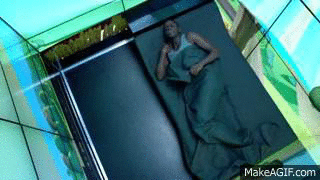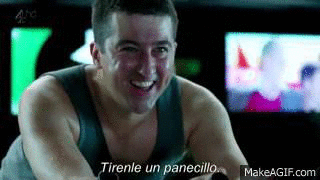Black Mirror: Fifteen Million Merits
Posted by Laura Dusi and Stephanie Lukito on October 31, 2014A British TV show, Black Mirror, presents an alternative approach to speculative design. The episode called “Fifteen Million Merits” (see youtube link at the end of post) happens in a possible future, where a reality TV show that we know mimics life, becomes life itself. In this future, citizens sustain their living by riding fixed bicycles to generate power in order to maintain the entertainment show they watch and live in. In exchange for the distance and time they ride, they receive currency. Entertainment is taken to the extreme and instead of being a moment of rest of our labor it becomes the labor and the motive to work. There is no boundary between play and obligation, sustaining and enjoying life.
In this scenario the technology also scales. Video games are so developed that they substitute real objects for virtual ones, defining every aspect of the citizen’s experience. The artificial apparently substitutes the human, by making predictions of their behavior and inducing it. Physical possessions are restricted, and you experience your entire through a screen on a bicycle. This is a brave new world of a post-physical reality. Representation is strictly virtual. In our present reality, we work to maintain the same system. Entertainment and pop culture are what motivates us and the artificial has already started to measure and mold our behavior. Our money is used as fuel and feedback loops that enhances the traps and lock-ins that we’ve created over time. The virtual has become part of our reality, presenting our current social and technological trends to the extreme.
This episode is packed with speculations based off of cultural criticisms of today. That what we find fascinating now is turned on its head into what defines us in this episode’s future. Here, the physical is the lowest form of being and the virtual rules at the top. The way this society functions is by using exercise bikes to power their entertainment. It’s a world beyond our concerns on energy and we’ve come to rely on ourselves for a source of power. The citizen’s only purpose in this reality is to power for entertainment. Everything leads up to a show called Hot Shots (like an America’s Got Talent), where you can win your chance to fame and free yourself from the the physical labor of the bicycle. We’ve been reduced down to popular talent show for meaning. There is no learning, no free information, no authentic expressions. The citizens save their funds to buy virtual goods, which in a way addresses today’s concerns about creating physical wastes. These are not solutions to today’s challenges. These are simply virtual illusions of what can be. Still, there is still value in fiction (we can say that speculative design in galeries fit in this concept), because it enhances what is most important in reality: it is through our relation with the artificial that we understand our humanity. What comes out of that, our interpretation of it, and our actions after that is what matters.
While presenting a speculation of the future, Black Mirror inserts skewed vignettes of our current realities. In the midst of hypertechnology, we see moments where it breaks down, fails, or humans manage to override it. The system still glitches as they do today, reminding us of the mechanisms that run it. For example, the food dispenser gets jammed, and the character has to hack it in order to receive his food. Or when he is presented with all of the advertisements, and he puts on his headphones instead to block out the noise. It situates our relationship to technology—that even though our relationships have changed, we are still human. A machine is still a machine, and we can still override it if we choose to do so (to some degree).
This episode also brings Jaron Lanier’s concept of “lock-in” to technology center stage. Aside from the citizen’s complete dependence on their powering bicycles, their entire reality is also locked in a virtual world. The main character threatens to kill himself live on the entertainment show Hot Shots as a protest, but instead was persuaded to become a star on their media channel. He was promised a better life, without physical labor, where he can sit and enjoy the outdoors. He agrees and gets his freedom away from the bicycle, but instead of leaving the system, he is just perpetuating it by becoming an entertainer in their virtual world. His fellow citizens are cycling to power his programming. In the end, you see him in a beautiful house, looking at a large “window” of a virtual forest. The critique here is that even when we think we are disrupting or breaking a system we are only perpetuating it. It might seem different but it is still in the same context, circling within the same reality. The paradox, or example, in this episode is that even when we see the enslaving side of entertainment shows and its vicious cycles, the show Black Mirror itself is very appealing entertainment. So we as audience might become more critical about the ideas revealed, but in reality, we are still watching and perpetuating the ideas criticized in the episode itself.
To bring this back to a design context, Black Mirror is a work of speculative design. It presents an alternate reality that breaks down our understanding of the world and rebuilds an uncanny alternative. As explained by Dunne & Raby, design seems a great tool as a “way to create spaces for discussion and debate about how alternative ways of being inspire and encourage people’s imaginations to flow freely”. However Black Mirror, unlike their work, is presented to a mass audience, through a channel grounded in mass culture instead of a gallery. Because galleries have a specific audience, the access of work inside is limited to an elite, so the first impact stays within that context and takes time to reverberate/resonate to the rest of society. The positive point about speculative work such as Black Mirror and other popular media is to widen access to the masses. It presents experimental design without the elite context of “art”. There is no pressure as an audience to critically reflect. But that is exactly the trade off. In a gallery setting, the viewer is pressured to think critically. As a form of entertainment, you are free to walk away with a more shallow satisfaction.



